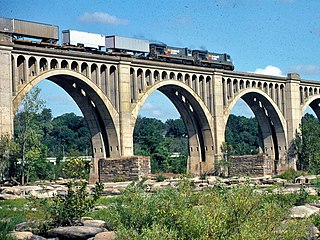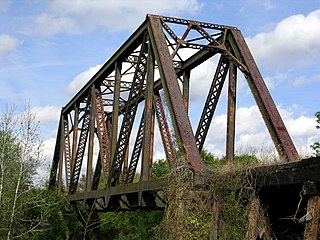
The Seaboard System Railroad, Inc. was a US Class I railroad that operated from 1982 to 1986.

The Atlantic Coast Line Railroad was a United States Class I railroad formed in 1900, though predecessor railroads had used the ACL brand since 1871. In 1967, it merged with long-time rival Seaboard Air Line Railroad to form the Seaboard Coast Line Railroad. Much of the original ACL network has been part of CSX Transportation since 1986.

The Seminole Gulf Railway is a short line freight and passenger excursion railroad headquartered in Fort Myers, Florida, that operates two former CSX Transportation railroad lines in Southwest Florida. The company's Fort Myers Division, which was previously the southernmost segment of CSX's Fort Myers Subdivision, runs from Arcadia south to North Naples via Punta Gorda, Fort Myers, Estero, and Bonita Springs. The company's other line, the Sarasota Division, runs from Oneco south through Sarasota. Seminole Gulf acquired the lines in November 1987 and operates its own equipment. The company's first train departed Fort Myers on November 14, 1987.
Gary is an industrial section located in the southeastern part of Tampa, Florida, mainly in the vicinity of Adamo Drive east of Downtown Tampa.
Florence Villa is a neighborhood within the city limits of Tampa, Florida. The ZIP Codes serving the neighborhood are 33605 and 33619. The neighborhood is part of the East Tampa region and is located within District Five of the Tampa City Council.

The Seaboard–All Florida Railway was a subsidiary of the Seaboard Air Line Railroad that oversaw two major extensions of the system in the early 1920s to southern Florida on each coast during the land boom. One line extended the Seaboard's tracks on the east coast from West Palm Beach down to Fort Lauderdale and Miami, while the other extension on the west coast extended the tracks from Fort Ogden south to Fort Myers and Naples, with branches from Fort Myers to LaBelle and Punta Rassa. These two extensions were heavily championed by Seaboard president S. Davies Warfield, and were constructed by Foley Brothers railroad contractors. Both extensions also allowed the Seaboard to better compete with the Florida East Coast Railway and the Atlantic Coast Line Railroad, who already served the lower east and west coasts of Florida respectively.
The Tampa Southern Railroad was a subsidiary of the Atlantic Coast Line Railroad (ACL) originally running from Uceta Yard in Tampa south to Palmetto, Bradenton, and Sarasota with a later extension southeast to Fort Ogden in the Peace River valley built shortly after. It was one of many rail lines completed during the Florida land boom of the 1920s. It was later known as the Atlantic Coast Line's Tampa—Southfort Line and Tampa—Sarasota Line on employee timetables. Most of the remaining trackage now serves as CSX Transportation's Palmetto Subdivision. Another short portion just east of Sarasota also remains that is now operated by Seminole Gulf Railway.
The Florida Western and Northern Railroad was a subsidiary of the Seaboard Air Line Railroad that expanded their network in the 1920s by building a rail line from Coleman, Florida all the way to West Palm Beach via Auburndale and Sebring, a distance of 204 miles. The line would be extended to Miami by the Seaboard-All Florida Railway, another Seaboard Air Line subsidiary, shortly after with the full line from Coleman to Miami becoming the Seaboard Air Line's Miami Subdivision. The line is still in service today from Auburndale to West Palm Beach and is now operated by Seaboard successor CSX Transportation as their Auburndale Subdivision.

The Palmetto Subdivision is a CSX Transportation rail line in the Tampa Bay region of Florida. It runs from just south of Tampa south to Bradenton.
The Brewster Subdivision is a railroad line owned by CSX Transportation in Florida. The line runs from the Valrico Subdivision at Edison Junction south through Bradley Junction to Arcadia for a total of 47.2 miles. It junctions with the Achan Subdivision and the Agricola Spur at Bradley Junction, and connects to the Seminole Gulf Railway in Arcadia.
The Jacksonville Terminal Subdivision is a group of railroad lines owned by CSX Transportation in and around Jacksonville, which was historically a major railroad hub. The Jacksonville Terminal Subdivision includes about 13.0 miles of track.
The Tampa Terminal Subdivision is a group of railroad lines owned by CSX Transportation in and around Tampa, Florida. The Tampa Terminal Subdivision covers track around Yeoman and Uceta Yards and is located at the end of two of CSX's U.S. East Coast main lines to Richmond, Virginia, the A Line and the S Line.
CSX Transportation's Valrico Subdivision is a railroad line in Central Florida. It serves as CSX's main route through a region of Central Florida known as the Bone Valley, which contains the largest known deposits of phosphate in the United States.
The Wildwood Subdivision is a railroad line owned by CSX Transportation in Florida. It runs along CSX's S Line from Baldwin south to Zephyrhills via Ocala and Wildwood for a total of 155.7 miles. The S Line is CSX's designation for the line that was the Seaboard Air Line Railroad main line from 1903 to 1967.

The Yeoman Subdivision is a railroad line owned by CSX Transportation in Florida. It runs along CSX’s S Line from Zephyrhills south to just east of Tampa via Plant City for a total of 31.2 miles.
CSX Transportation's Atlanta Terminal Subdivision comprises the company's railroad lines and infrastructure operating in and around Atlanta, Georgia. The Atlanta Terminal Subdivision consists of five lines and a number of yards. Most of the lines in the Atlanta Terminal Subdivision date back to the 1800s.

The Charleston Subdivision is a railroad territory owned by CSX Transportation in the U.S. states of South Carolina and Georgia. The line from Florence, South Carolina, to Savannah, Georgia, for a total of 195.8 miles. At its north end it continues south from the South End Subdivision and at its south end it continues south as the Savannah Subdivision of the Jacksonville Division.
The Winston and Bone Valley Railroad was a railroad line running in the Bone Valley region of Central Florida. It connected to the South Florida Railroad main line near Lakeland. A vast majority of the line remains in service by CSX Transportation, who operates it today as their Bone Valley Subdivision.

The Seaboard Air Line Railroad's Sarasota Subdivision was a rail line that ran from the company's main line at Turkey Creek south to Palmetto, Bradenton, Sarasota, and Venice. The line was built in phases from 1901 to 1911.
The Atlantic Coast Line Railroad's DuPont—Lakeland Line was a historic rail line in southern Georgia and the northern west coast of Florida. On employee timetables, the line was actually divided into the DuPont—High Springs Line and the High Springs—Lakeland Line. The line was primarily used for freight, though some passenger services ran on parts of it in Florida. While parts of the line were built as early as 1863, the full line was not complete until 1913. Parts of the line in Florida are still active today.








